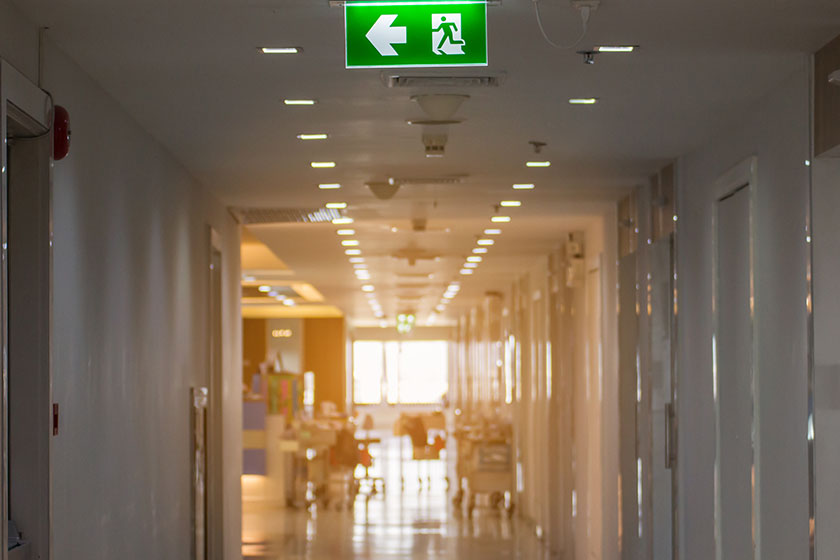NFPA Guidelines For Hospital Fire Safety: A Practical Checklist

When one is in charge of safeguarding hospital environments, familiarity with the National Fire Protection Association (NFPA)’s industry regulations is paramount. These guidelines, particularly the NFPA 101 Life Safety Code and NFPA 99 Health Care Facilities Code, establish the framework for hospital fire safety protocols.
Compliance with these standards is not just a legal requirement but also a moral obligation to protect the well-being of everyone within the facility. By adhering to NFPA guidelines, you’re proactively mitigating potential risks and creating a safer environment for patients, visitors, and staff alike. Here’s a practical checklist you can use to ensure your hospital’s compliance with NFPA standards.
Backup Power Systems and Generators Testing
In the event of a power outage during a fire emergency, reliable backup power systems are critical for maintaining essential operations within the hospital. Understanding essential electrical systems (EES), as defined by NFPA 99, is key to ensuring continuous power supply to designated areas of the facility.
Compliance with NFPA 99 Chapter 6 for backup power systems dictates the installation, maintenance, and testing requirements for generator sets. Regular maintenance and testing of generator sets are essential to verify their functionality and readiness to provide backup power during emergencies.
Following these guidelines means that hospitals can minimize disruptions to critical operations and ensure the safety of patients and staff.
Compartmentation Obligations
Compartmentation serves as a passive fire protection measure, crucial for containing fire and preventing its spread within a healthcare facility. NFPA guidelines, particularly outlined in NFPA 101 Chapter 18, provide specific requirements for constructing and maintaining fire-resistant barriers such as walls, doors, and corridors.
By adhering to these requirements, you’re creating vital barriers that can significantly mitigate the impact of a fire, allowing for safe evacuation and minimizing potential damage. Compliance with compartmentation standards is essential for enhancing fire safety in hospitals and protecting lives in times of emergency.
Documentation and Compliance
Documentation and record-keeping are fundamental aspects of maintaining fire safety compliance in hospitals. Keeping detailed records of inspections, testing, and maintenance activities ensures accountability and transparency in the management of fire safety systems.
NFPA standards provide guidelines for record-keeping practices, outlining the information that should be documented and the frequency of record updates. Ensuring the availability of documentation for inspecting authorities, such as fire marshals and accreditation agencies, is essential for demonstrating compliance with regulatory requirements and maintaining a safe healthcare environment.
Emergency Preparedness and Evacuation Plans
Emergency preparedness is the core foundation of fire safety in hospitals. Developing and implementing comprehensive emergency procedures, including evacuation plans, is vital for effectively responding to fire incidents. Recurring training and drills for hospital staff ensure they are familiar with emergency protocols and can act swiftly and confidently in the event of a fire.
Compliance with NFPA guidelines for evacuation drills, as outlined in NFPA 101, ensures that evacuation procedures are practiced regularly and effectively. These drills simulate real-life scenarios, helping to identify areas for improvement and ensuring that staff are adequately prepared to evacuate patients and visitors safely.
Fire Alarm Systems Checks
As part of the overall checklist for fire safety, it’s imperative to ensure that fire alarm systems are installed according to NFPA guidelines, with consistent maintenance carried out to keep them in optimal working condition. Regular inspections and testing are essential to identify any faults or issues promptly.
Fire alarm systems must adhere to the NFPA 72 National Fire Alarm and Signaling Code, which outlines the installation, testing, and maintenance requirements for these systems. Fire alarm systems must also be integrated with other building systems, such as HVAC and emergency lighting, to facilitate a coordinated response to emergencies.
This integration enhances the overall effectiveness of the hospital’s fire safety plan and guarantees a comprehensive approach to emergency management.
Fire Suppression Systems Checks
Effective fire suppression systems are essential components of hospital fire safety protocols. NFPA standards such as NFPA 13 outline requirements for the installation and maintenance of fire sprinkler systems, which play a crucial role in quickly containing and extinguishing fires. Regular inspection and testing ensure these systems remain in optimal working condition, ready to respond to any fire emergency.
Additionally, NFPA 10 provides guidelines for the use and inspection of fire extinguishers throughout the facility. Proper placement, maintenance, and staff training on fire extinguisher operation are key aspects of this checklist item.
Furthermore, specialized fire suppression systems designed for high-risk areas such as kitchens and hazardous environments require thorough inspection and maintenance frequently to ensure their effectiveness in controlling fires specific to these locations.
Functional Systems Requirements
Hospital operations rely on a multitude of functional systems, from gas and electrical to communication and plumbing. Each system plays a vital role in maintaining the facility’s day-to-day operations and, more importantly, ensuring fire safety in hospitals.
By following NFPA standards outlined in chapters such as NFPA 99 Chapter 5 for gas systems and NFPA 70 for electrical systems, you can ensure that these critical components are installed, inspected, and maintained according to the highest safety standards.
Strategic Cooperation Between Hospital Administrators, Managers, and Safety Professionals
For hospital administrators in particular, achieving and maintaining compliance with NFPA guidelines is paramount to ensuring hospital fire safety for every staff, patient, and visitor they are in charge of in the entire facility. Implementing these guidelines effectively requires strategic planning and collaboration between facility managers and fire safety professionals.
With proper open communication and cooperation between these stakeholders, administrators can streamline the implementation process and address any challenges that may arise.
Training and Education for Hospital Staff
Continuous training and education on fire safety practices are essential for hospital staff at all levels. Hospital administrators should prioritize ongoing training programs to ensure that staff remain knowledgeable about fire safety protocols and procedures, importantly the operation of fire alarm systems and how to respond in the event of an alert.
With careful planning, collaboration, and ongoing education, hospitals can enhance their fire safety measures and create a safer environment for all.
Advancing Hospital Fire Safety Through NFPA Guidelines and Fire Safety Alarms, Inc.
It’s clear that adherence to NFPA guidelines plays a pivotal role in ensuring hospital fire safety and mitigating fire risks. With the implementation of these key checklist items outlined by NFPA standards, hospitals can establish robust fire safety protocols that protect lives and property.
Fire alarm systems, in particular, are a critical component of any hospital’s fire safety plan, serving as an early warning system that facilitates a prompt response. At Fire Safety Alarms, Inc., we provide a full suite of fire alarm services including fire alarm system designs and installations, professional servicing and maintenance, as well as inspections and approval procedures for hospitals and other commercial buildings.
We are a premier provider of fire protection services around the bustling New York City metropolis, and our expertise spans from fire alarm engineering to emergency management and services. Call us today at (201) 963-4030 to advance your hospital’s fire safety measures and remain compliant with NFPA Guidelines.
